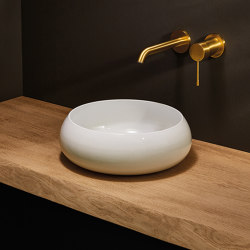Bette does time at the Wilmina Hotel, a former prison
Brand story by Simon Keane-Cowell
Zürich, Switzerland
28.11.23
With elegant, tailor-made bathroom products, Bette has helped Grüntuch Ernst Architekten transform one of the most unlikely places to find high-class hospitality – a former prison – into a luxury hotel.
It could've been so kitsch.
When you hear that a former prison has been transformed into a hotel, you'd be forgiven for imagining an incarceration-themed novelty destination, replete with door handles in the shape of handcuffs and complimentary striped pyjamas.
Grüntuch Ernst Architekten's sensitive adaptation of a women’s jail in Berlin-Charlottenburg is anything but, however. The landmark building, originally completed in 1896, has been carefully honed into a place of light and tranquility, and has already managed, since its opening last year, to cultivate a loyal community of discerning – and returning – guests in search of restorativeness rather than restorative justice.
‘We never woke up and decided to buy a prison and run a hotel,’ explains co-founder Almut Grüntuch Ernst. (She and her partner Armand Grüntuch are both Wilmina’s architects and its owners.) ‘It’s the kind of story you just grow into.’
Not an undertaking for the faint-hearted, the project took almost a decade to realise. Interventions included the merging of inmates’ cells to produce more generously sized guest rooms, the creation of new communal spaces, including the hotel’s restaurant (which was formerly an outdoor courtyard), and the planning of an expansive and heavily planted garden – an urban oasis whose reviving verdancy is echoed in the greening of several of the lower-level rooftops.
Guiding light into the building was critical to the new hotel’s viability as a place of hospitality and was delivered via two major design decisions. The first, the introduction of generous daylight at high level into the main atrium, and the second, the painstaking process of opening up the small window apertures in the cells by cutting into the external brickwork facade – while, importantly, retaining the original metal bars on the windows.
The architects’ emphasis on honest materiality throughout the project extended to the guest bathrooms, where they specified Made-in-Germany brand Bette, known for its long-life enamel-steel products. Their robustness, married with a tactile friendliness, was a significant factor here, but not the only one. ‘All the cells have different dimensions in the width, and with Bette we found a great partner who can tailor-make their on-floor shower trays.’
But Wilmina isn’t just an exercise in conversion. ‘It was very important for us to build the penthouse level and the terrace,’ explains Armand, ‘because only with elements of contemporary architectural expression can you really enjoy and value the historic, monumental qualities.’
© Architonic
Head to the Architonic Magazine for more insights on the latest products, trends and practices in architecture and design.







